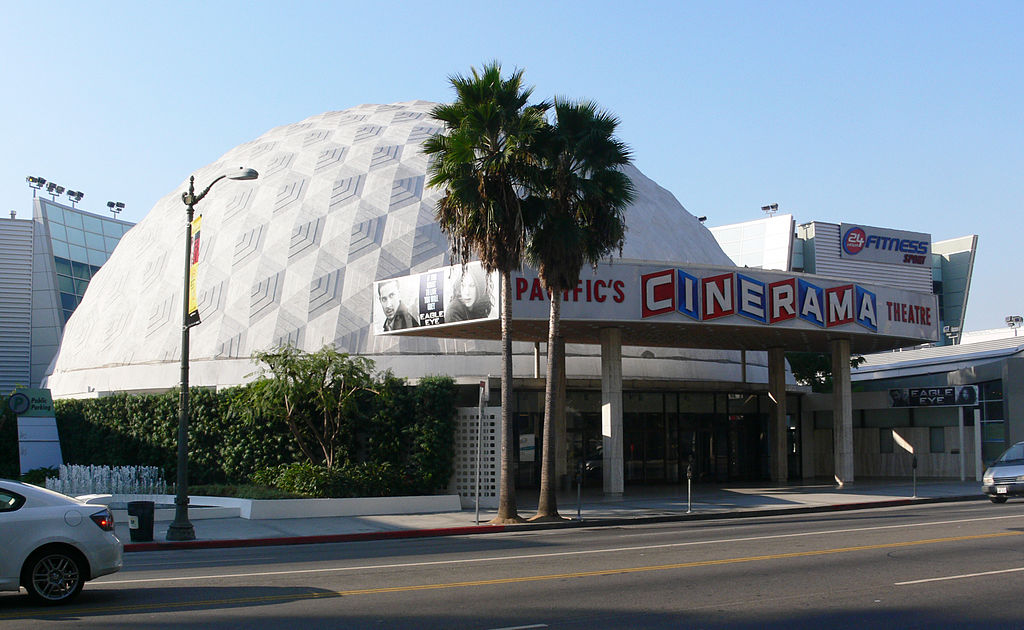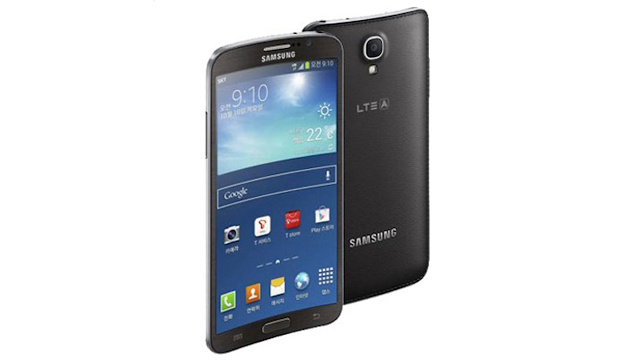They’ve been a vital aspect of movie theatre visuals for years, but curved displays have become increasingly common on small screens — specifically high-end OLED televisions and adventurous smartphones. But are curves in your TV or phone really the wave of the future? Or just another marketing gimmick?

Why Curved Works For Movie Theatres
Many movie theatres, such as Hollywood’s Cinerama Dome, employ horizontal-curved screens to correct for the distortions caused by projecting the image at very large sizes and super-wide formats like 23:9 Cinemascope.
When you project an image onto a completely flat screen from a single fixed point (i.e. the projector room), the light has to travel farther from the projector lens to reach the edges of the screen than it does to the center. This causes the image to bulge along the sides, and pull in along the top and bottom. It’s known as the pincushion effect, and it makes for a murky viewing experience.
But by incorporating a horizontal curve to the screen — thereby pushing the edges of the screen closer to the projector — theatre operators can negate the distortion and create an image that’s perceived as flat by the audience. Even then, restraint is cautioned; as Dr. Raymond Soneira, CEO of Displaymate, explained to Gizmodo, “the focal planes of almost all cameras are flat rather than curved, so a small amount of geometric distortion is introduced using a curved screen. The curvature should be kept small.”
This negating effect diminishes the further you move away from the theatre’s “sweet spot,” which is why it’s so important to pick the right seat when you go to the movies.
Curvature is, not surprisingly, also used extensively on the super-sized screens found in IMAX theatres. As Brian Bonnick, Chief Technology Officer, IMAX Corp, explained to Gizmodo, it’s helpful not just to fight the pincushion effect but to make for a better 3D experience:

More recently, with the introduction of highly-directional silver screens for IMAX 3D, we rely on the curved screen to help direct more light back to the audience. This helps to give the audience a more even distribution of light across the screen and reduce “hot-spots”, an area on the screen that appears much brighter than the rest of the screen. This provides for a much brighter, clearer movie when experienced in IMAX 3D.
But What About Your TV?
The pincushion effect is not an issue with televisions, though, since they emit their own light and, outside of 21:9 curiosities from Vizio and Philips, the standard HDTV’s 16:9 aspect ratio isn’t wide enough to cause any real distortion. So why bother to curve an home television screen at all then?
Actually, there are a couple of reasons.
Hitting the Sweet Spot
Just like at the movies, there’s an optimum position for watching your home television. THX recommends that the display fill 40 per cent of your field of vision. You can therefore calculate the optimal distance from your television by solving for distance: Screen Size/0.84 = Distance. (Why .84? Because THX says so.)
However, unlike the relatively large movie theatre “sweet spot” that can accommodate a dozen viewers, the sweet spot in your living room covers one, maybe two people at most. This means that the best place to watch is from direct center, with the middle of the screen at eye height. Anyone outside of this pocket will experience slight-to-substantial video quality degradation as well as an increasing “keystone” effect — that is, the farther corners of the TV appear closer together than the nearer corners — the further off center the viewer is sitting.
The concave screens found on LG and Samsung’s new fancy-pants OLED HD television help to mitigate this keystone effect and improve visibility for people outside the sweet spot because the slight curve increases the effective viewing angle. LG’s 55-inch EA9800 OLED for example, “is just slightly curved, with a radius of curvature of 16.4 feet (5.0 meters), so the corners of the screen are only 1.4 inches (3.6 cm) forward of the rear (center) of the screen,” Dr. Soneira writes. That little bit of bend can make a big difference:
When you watch a perfectly flat TV screen, the corners of the screen are further away than the center, so the eye sees a double trapezoidal (keystone) distortion of the screen rather than as a rectangle. But the image you actually see appears perfectly straight because the brain corrects for the keystone distortion — which is actually much larger than the pincushion distortion from a curved screen. So after watching for a period of time the brain will presumably compensate for the very subtle curve of the screen in the same way that it straightens out the trapezoidal screen.
In other words, when faced with a less than ideal viewing angle the brain performs what is known as “perceptual adaptation” or more commonly, “getting used to it.” It accounts for the differences in the incoming visual information versus what it normally would be and “adapts” that information to better fit with the mental model.
So, for example, when you first get a new glasses prescription that’s way more powerful than what you’re wearing, everything appears heavily distorted at first. Eventually you get used to it and everything appears “normal.” The same thing happens when you watch TV from an angle; at first it looks like a keystone, but after a while you get used to it. With a curved screen, that adjustment happens faster, because there’s less too adjust for.
Dimming the Lights
Another, more noticeable advantage to a curved television screen is its ability to cut down on ambient light reflections. Not only does it mitigate reflections from side lighting — think the lamp on your media center — by reducing the screen’s open angle, it also reflects what light does strike the screen away from the viewer.
With less light washing out the on-screen picture, blacks appear blacker while contrast and colour accuracy improves.

Curve Your Enthusiasm
While LG and Samsung both tout their billboard-sized 100-inch-plus OLEDs as providing an immersive, cinematic view, there are limits to how much curvature a television viewer can handle. If the screen curves too much, it not only negates the keystone effect, it becomes a distraction in its own right. And that curvature can even potentially block a portion of the screen for viewers seated to the extreme left or right of center, as Arstechnica explains.
What’s more, you can’t really mount them. For most folks shopping in the TV-or-a-Hyundai price bracket, the inability to mount a curved set on the wall where the flat screen used to sit could be an outright deal-breaker.
And then there’s the cost; the cheapest you can get a curved Sony right now is $US3000; Samsung’s will set you back $US9000. Which seems like a heavy premium for not much perceptible gain.

What About Mobile?
As gimmicky as recent curved smartphones might seem, a curved display benefits mobile devices in many of the same ways it does a TV. Curving the edge of a phone’s display, even slightly — on the Samsung Galaxy Round, for example, the edges of the screen are just 1/10th of an inch higher than the center — noticeably reduces the screen’s degree of reflectance in ambient light. This is important since, unlike TVs which are best viewed in semi-darkened rooms, phones are used almost exclusively under ambient lighting conditions.
A quick example: Turn off your cell phone screen and look at the display. See all that reflected light with your head back-shadowed in the center? That’s reflected light that diminishes the image emitted from the phone, requiring you to boost the screen brightness which draws more power which accelerates battery drain.
But a curved phone, much like a curved TV, reduces the open angle of the screen, which blocks out some side light while reflecting another portion away from the viewer’s eyes. And, more importantly, the concave shape of the phone (when held in portrait mode) causes a slight magnification effect. So when you’re looking at a curved phone screen, that magnification effect is horizontally expanding the reflection of your head by a factor of at least 2x, blocking out additional light reflections and requiring less luminescence from the screen to overcome the ambient light.
As Dr. Soneira writes, “the Galaxy Note 3 and Galaxy Round have about 5 per cent Reflectance, among lowest I have ever measured for mobile displays.” A similar Displaymate test performed on tablets revealed the flat-faced Nexus 7 and iPad Retina Air had an average reflectance of 5.9 and 7.7 per cent, respectively.
Granted, a 1 to 3 per cent drop may not seem like much, but any degree of improvement should translate into a noticeable boost in battery life — the dimmer you can keep your phone, the less quickly you’ll drain your juice.
All of which is to say that curved screens really are better in most cases; whether they’re better enough is between you, your checking account, and design aesthetic [Displaymate 1, 2 – The Guardian – Cnet – How Stuff Works]
Picture: Andreas Praefcke
